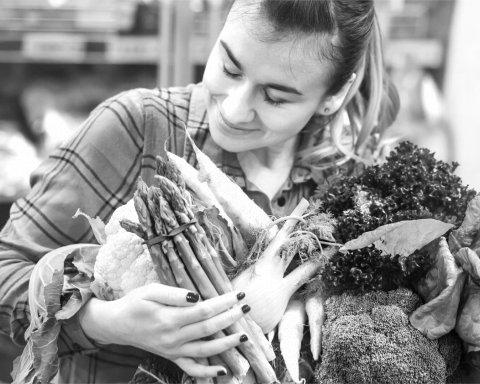Food appearance plays a significant role in food waste, as consumers often prioritize visually appealing and nutrient-rich choices. However, it’s important to note that variations in the size, shape, and appearance of fruits and vegetables can occur during the growth and harvesting process, although their nutritional value remains consistent.
The consumer preference for flawless produce results in a staggering 40% of edible produce going to waste, and this phenomenon’s impact on environmental sustainability and food security is significant. Agricultural items are categorized as ‘ugly food’ if discarded due to their unappealing appearance.
If you want to explore facts and insights concerning ugly food and consumer behavior and promote mindfulness in your food purchases, this article is for you.
Psychological and sociocultural factors influencing food choices
Several things might affect a consumer’s decision to buy food items. It may begin with psychological reactions to unsightly things and the stigma that society creates around them.
Perceptions of beauty and aesthetics
Unconsciously, consumers look for indications of food quality and safety, with aesthetics being one of the main characteristics they utilize as subconscious quality indicators.
The “beauty is good” bias affects consumers’ judgments on difficult-to-assess qualities like brand personality and believability. One study shows that even though practitioners often use moral justifications, they may be ineffective in dispelling the myth that ‘ugly’ doesn’t always mean ‘bad.’
Ugly food shame and stigma
People assume that a food’s naturalness signifies healthfulness, both in terms of the presence of good factors (like nutrients) and the absence of bad aspects (like calories), when it happens to appear beautiful (Hagen, 2020).
But when it comes to ugly food, people’s opinions about what looks good or bad can vary. Some individuals believe that attractive food is superior while considering ugly food inferior.
People who think this way are more likely to see risky aspects in unattractive meals and avoid buying them. However, people with different perspectives don’t seem to have these biases.
Economic considerations
Opting for only visually appealing produce can lead to higher costs and contribute to food waste. Being open to purchasing and consuming ugly produce can save money and support sustainable practices in the food industry.
Retail and supply chain practices
The absence of markets for ugly food largely causes food loss in farms. To satisfy customer desires for the product’s appearance, they frequently go unharvested or are eliminated from the supply chain during processing.
When creating markets for unappealing foods, the common prevailing strategy involves undervaluing these items and accentuating their contribution to reducing food waste.
Several ways can ensure a reduction in food waste and potentially increase revenue for retailers and suppliers. These include:
- Emphasis on the fact that non-standard items are healthy, delicious, and natural and that buying them can help reduce the social ills related to food waste.
- There is potential to increase revenue for retail and suppliers by combining standard and unappealing products for marketing purposes.
- Package imperfect fruits and vegetables together in value packs, making it convenient for shoppers.
Pricing and consumer behavior
One issue with most ugly food campaigns is that they encourage people to purchase imperfect produce by offering price reductions. Unfortunately, this approach tends to reinforce unfavorable conclusions.
Consumers may associate discounted products with lower quality, relying on heuristics like the price-quality inference. Such practice perpetuates the idea that food with aesthetic flaws is indeed subpar, making these price reductions potentially less viable. Discounts should be used in this particular situation with more care.
Solutions to reduce ugly produce waste
Innovative solutions to the issue of ugly produce waste have surfaced in response to rising global concern about food waste. This section examines several strategies and programs designed to decrease the amount of discarded imperfect fruits and vegetables.
These solutions, which range from innovative marketing strategies to consumer education and awareness, reduce food waste and advance affordability and sustainability in the food system.
Consumer education and awareness
It will be tough to improve customer awareness and change consumer behavior toward ugly food by boosting understanding. Aside from issues with quality, low levels and various types of awareness also have an impact on customer behavior.
Research found that increasing consumers’ knowledge of environmental issues does not seem to be sufficient to persuade them to pick ugly food. Therefore, you can focus on nutritional issues to increase consumer awareness of ugly food.
Nutritionally ugly fruits and vegetables are just as nutritious as the pretty ones. They have all the important vitamins, minerals, nutrients, and sometimes even more when ripe.
Eating ugly food helps reduce food waste and supports sustainable farming. As people learn more about the benefits of ugly food, it’s becoming clear that one should focus on quality, taste, and nutrition rather than how food looks.
Accepting ugly food promotes a larger, more inclusive understanding of beauty and undermines socially sanctioned ideals of perfection. It encourages the concept that a dish’s imperfections may offer charm, enhancing its relatability and authenticity. Therefore, when ugly food becomes more popular, ideas of beauty and aesthetics change to place a higher value on substance and sustainability.
Retailer and industry initiatives
The study reveals that offering suboptimal food negatively impacts store image, affecting consumer perceptions of the store’s practices and treatment. Offering suboptimal food should be accompanied by explaining the why, how, and significance of the price cut to lessen the detrimental effect on the shop’s image.
Retailers have begun to understand that the quality and taste of produce are not determined by how it looks, which has led to the creation of separate sections in stores for such goods.
Partnerships between the food industry and groups working to rescue and redistribute unpleasant food to those in need have also grown to support these activities.
Creative ways to use ugly produce
Creative uses for ugly food emphasize the potential that may be discovered despite its imperfections. One inventive solution is to use ugly fruits and vegetables to make colorful and flavorful smoothies. These ugly food items may be combined with other foods like yogurt, honey, and spices to make tasty, nutrient-rich beverages that look good.
Another creative use is to make homemade vegetable stock or broth. Those ugly carrot, onion, and celery stalks may be transformed into a delicious base for soups, stews, and sauces.
In conclusion
Buying imperfect or ugly foods benefits the environment because you help create a more sustainable future. Food waste is a major problem worldwide, with tons of perfectly edible and healthy produce being thrown away because it doesn’t meet the rigid visual standards set by retailers.
By breaking away from this superficial mindset, one can reduce the enormous amount of resources wasted in the production, transportation, and disposal of food that doesn’t make it to your plates.
When farmers and growers know that products on the market may not look traditionally appealing but still taste good, they are more likely to grow diverse and unique fruits and vegetables. This helps maintain the genetic diversity of one’s food supply, making it more resilient to pests, disease, and changing environmental conditions.
So, the next time you fill your shopping cart, remember that choosing ugly products is a small but effective step you can take to reduce food waste, support sustainable agriculture, and promote a healthier planet for future generations.
If you would like to see more resources on food waste, check out the Household Management Science Labs. The lab uses the research of the Institute for Life Management Science to produce courses, certifications, podcasts, videos, and other tools. Visit the Household Management Science Labs today.
Photo by monicore on Pexels





